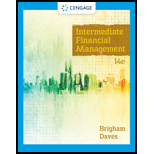
Concept explainers
a)
To determine: Definition of preferred stocks
Introduction: Hybrid financing refers to the raising of funds to finance the operations of the business by using the instruments that carry the features of both common equity and the debt.
a)
Explanation of Solution
b)
To determine: Definition of cumulative dividends and arrearages.
b)
Explanation of Solution
The preferred stockholders have the option to cumulate the dividend if they didn’t get the dividend in the year of losses. The cumulative dividend is the unpaid amount of dividend not paid in the years of losses and cumulate to the subsequent years till it get fully paid out of the profits of the company before making the payment to the common stockholders.
Arrearages refer to the amount of the preference dividend that is not paid to the holders and are in arrears.
c)
To determine: Definition of warrant and detachable warrant.
c)
Explanation of Solution
An option which entitles the holder with the right to buy a specified number of shares at the pre-stated price is known as warrant.
The warrant is attached to a security and the warrants that can be detached from the underlying security at the time of trading the warrants are known as detachable warrants.
d)
To determine: Definition of stepped-up price.
d)
Explanation of Solution
Stepped-up price refers to the increase in the strike price of the underlying security of a warrant or option over the defined period of time. The securities with step-up price do not attract the investors and incorporated in the warrants so that the holders exercise them within the time period.
e)
To determine: Definition of convertible security.
e)
Explanation of Solution
The option provided to the holders of certain bonds or preferred stock to convert their existing securities to the common stock after the expiry of a certain period. These bonds and preferred stock are known as the convertible securities.
f)
To determine: Definition of conversion ratio, conversion price and conversion value.
f)
Explanation of Solution
The number of equity shares to be received by converting the one convertible security at the time of conversion is known as convertible ratio.
The price of the share that is effective at the time of conversion of the convertible security known as conversion price. It is the price for which the securities can be converted into the common stock. It is calculating by dividing the par value of the security to be converted to the conversion ratio.
The conversion value refers to the financial value of the common stock that is received by the security holder at the time of the conversion of the security. It is calculated by multiplying the market price of each share and the conversion ratio.
g)
To determine: Definition of sweetener.
g)
Explanation of Solution
The debt instruments are added with a feature in order to attract the investors to invest for lower yields by providing them the option either to convert their security to the common shares or purchase the shares at the lower price than that of market price. This feature of debt instruments is referred as the sweetener.
Want to see more full solutions like this?
Chapter 20 Solutions
INTERMEDIATE FINANCIAL MGMT.(LOOSE)
- Explain how an increase in interest rates by a central bank could affect bond prices and stock market performance. Explanation.arrow_forwardWhat is the purpose of diversification in an investment portfolio, and how does it reduce risk?arrow_forwardExplain how an increase in interest rates by a central bank could affect bond prices and stock market performance.arrow_forward
- What is the purpose of diversification in an investment portfolio, and how does it reduce risk? Need help!arrow_forwardWhat are the key differences between a company’s income statement and its cash flow statement? Why are both important for financial analysis? Need help!arrow_forwardWhat are the key differences between a company’s income statement and its cash flow statement? Why are both important for financial analysis?arrow_forward
- What is the relationship between risk and return in finance, and how is this reflected in the Capital Asset Pricing Model (CAPM)? Explain.arrow_forwardDefine the time value of money (TVM). How does TVM influence decision-making in capital budgeting? Explanation.arrow_forwardWhat is the relationship between risk and return in finance, and how is this reflected in the Capital Asset Pricing Model (CAPM)?arrow_forward
- 3. Explain the concept of compounding. How does compounding impact the future value of an investment? Need help!arrow_forward3. Explain the concept of compounding. How does compounding impact the future value of an investment?arrow_forwardWhat is the difference between a stock and a bond, and how do they function as investment options? Need help now !arrow_forward
 Cornerstones of Financial AccountingAccountingISBN:9781337690881Author:Jay Rich, Jeff JonesPublisher:Cengage LearningPrinciples of Accounting Volume 1AccountingISBN:9781947172685Author:OpenStaxPublisher:OpenStax College
Cornerstones of Financial AccountingAccountingISBN:9781337690881Author:Jay Rich, Jeff JonesPublisher:Cengage LearningPrinciples of Accounting Volume 1AccountingISBN:9781947172685Author:OpenStaxPublisher:OpenStax College EBK CONTEMPORARY FINANCIAL MANAGEMENTFinanceISBN:9781337514835Author:MOYERPublisher:CENGAGE LEARNING - CONSIGNMENT
EBK CONTEMPORARY FINANCIAL MANAGEMENTFinanceISBN:9781337514835Author:MOYERPublisher:CENGAGE LEARNING - CONSIGNMENT


